Even if you’ve never made homemade bread or worked with yeast before, this homemade crusty artisan bread is for you. It’s the perfect beginner recipe because it only requires 4 ingredients without any special pans or mixer, there’s no kneading or complicated shaping involved, and 95% of the work is hands-off. Bread masters will appreciate this recipe too because it delivers with delicious flavor, a slightly crisp and mega chewy crust, and those signature soft holes inside like ciabatta or French bread.
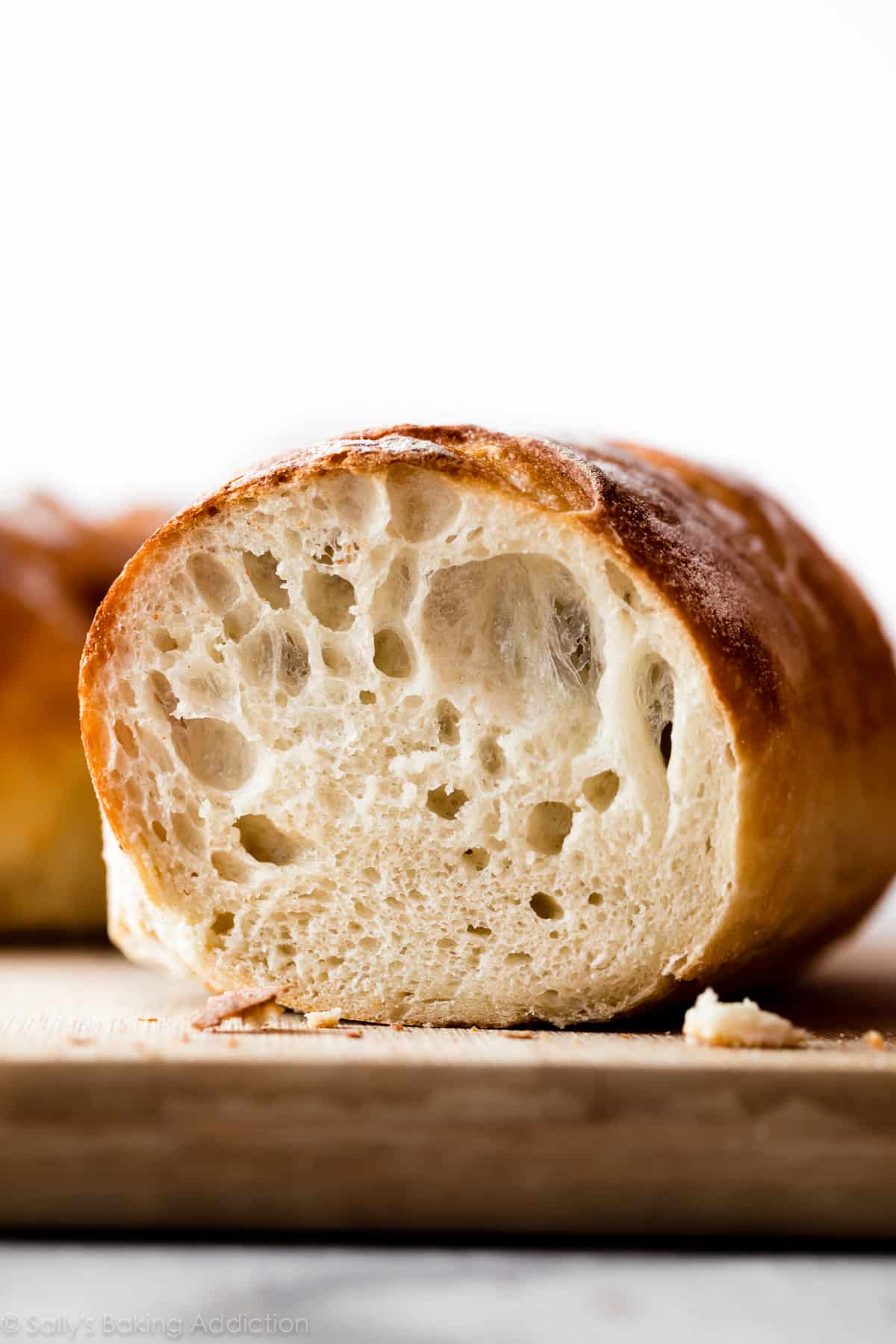
Bread Beginners—Start Here
Have you ever wanted to master homemade bread? Real, crusty, chewy, delicious bakery-style loaves that taste incredible with dips, soups, sauces, and comforting dinners? This recipe is where you start. This artisan bread is for beginners, but even bread masters will appreciate its flavor and ease. It’s so fresh, so flavorful, and so surprisingly easy because it basically makes itself.
You only need 4 ingredients without any special pans or mixer, there’s no kneading, no poolish or dough starter required, and you can add herbs, cheeses, and spices to make a variety of bread flavors.
This base recipe will soon be on repeat in your kitchen. After you realize how easy it is to make real homemade bread, you’ll find any excuse to bake a loaf.
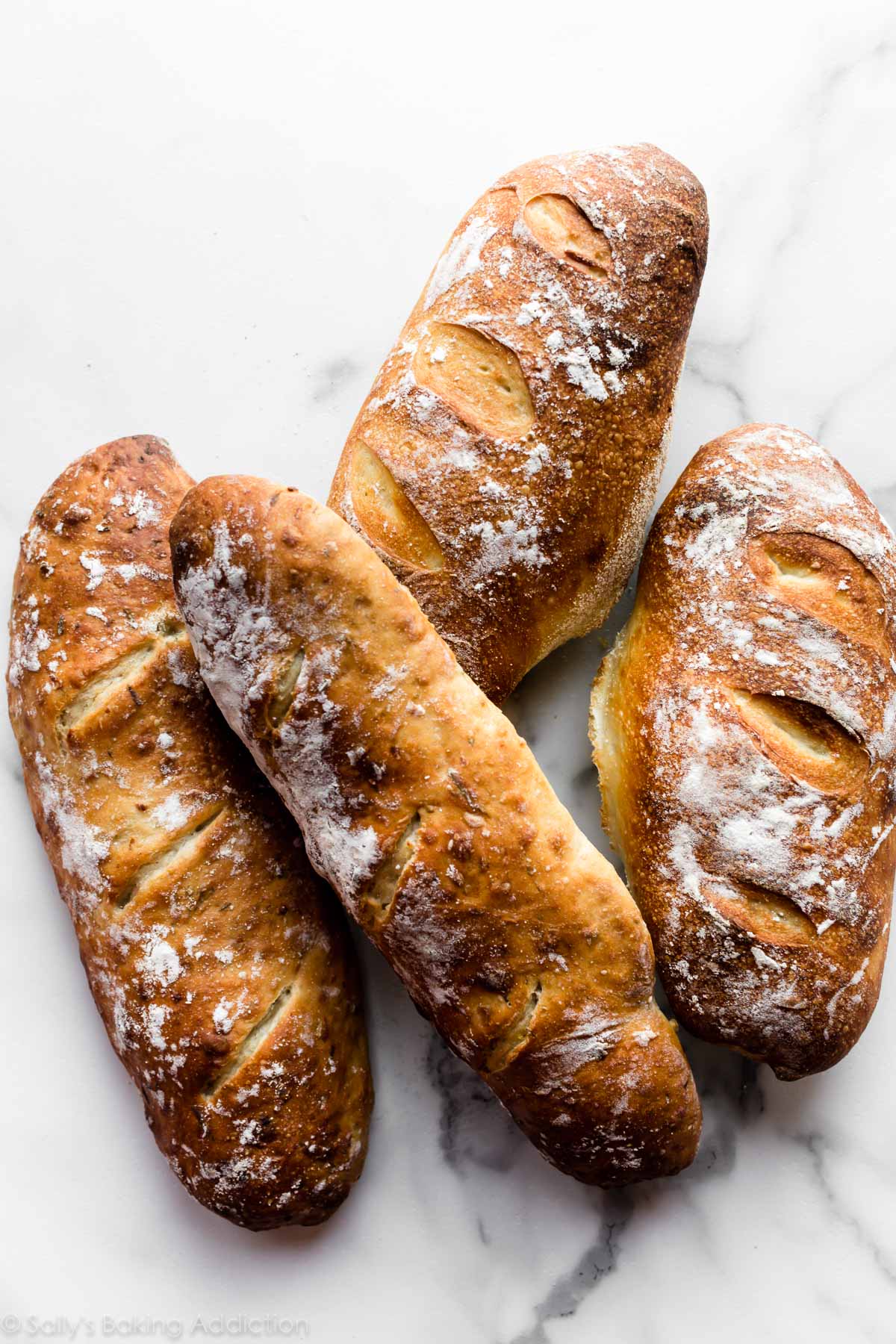
What is Homemade Artisan Bread?
When it comes to bread, the term “artisan” doesn’t mean 1 particular thing. But generally, artisan bread is homemade, fresh, crusty, and deliciously rustic looking. An artisan is a skilled worker, one who works with their hands. But ironically, there isn’t much “work” involved with this recipe.
Why You’ll Love This Bread
- Easier than you ever imagined
- Soft + flavorful
- Chewy, slightly crisp crust
- Shape however you want
- No special pans, poolish, or dough starter required
- Only 4 ingredients
- You decide the length of time it rests
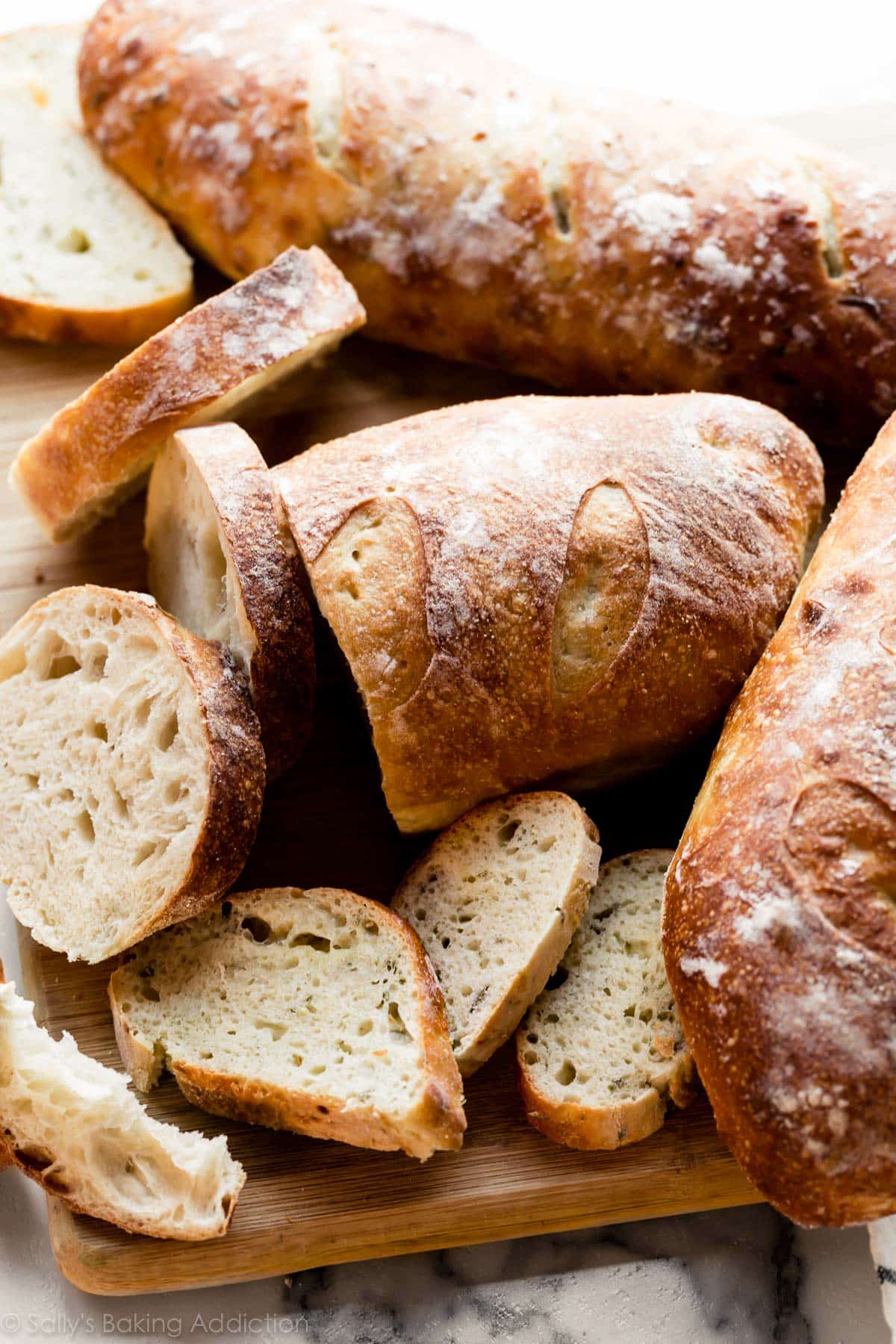
Homemade Artisan Bread Video Tutorial
Like sandwich bread, whole wheat bread, focaccia, homemade English muffins, seeded oat bread, and homemade bagels—the process is surprisingly easy. If you’re new to yeast, reference my Baking with Yeast Guide for answers to common yeast FAQs.
Only 4 Ingredients
The crustier and chewier the bread, the less fat in the dough—also known as a “lean dough.” We’re using a lean dough for our artisan loaf today. (If you’re curious, a “rich dough” is a soft bread dough with the presence of fat, such as butter and eggs—the kind we need for overnight cinnamon rolls and honey butter rolls.) Without fat, we’re left with the basics.
- Bread Flour: While you can use all-purpose flour in this recipe, I strongly recommend using bread flour. Just like when we make olive bread and asiago-crusted skillet bread, bread flour produces a stronger, chewier bread and that makes a big difference in recipe with only 3 other ingredients.
- Instant Yeast: Instant yeast is key in this recipe. While you can use active dry if that’s all you have, any quick rise or instant yeast will produce flavorful results in less time. I use more yeast in this recipe compared to my cranberry nut no-knead bread and no-knead jalapeño cheddar bread. Why? Those doughs rest and rise at room temperature. However, for more flavor and just as much rise, I use more yeast and let the this dough rest in the refrigerator. (Cool air slows the fermentation process.)
- Salt: You can’t make good bread without salt and for best flavor, I recommend a coarse salt, such as coarse sea salt. I find the bread’s flavor lacking with regular table salt.
- Water: I normally encourage you to use warm liquid with yeast because warm liquid helps the yeast work faster. However, use cool or room temperature water here. Not freezing cold, not super warm—cool to touch. 70°F (21°C) is great, but the exact temperature doesn’t matter as long as it’s not hot or warm. The cooler the water, the longer the dough takes to rise and, usually, the better the bread’s flavor. (This is important since there are so little ingredients to add substantial flavor!) We use the same cool water method for no knead honey oat bread.
- Optional Cornmeal: Dusting the pan with cornmeal adds a pop of flavor and a little crunch to the bottom crust. This is completely optional. If you have it, use it. If you don’t have it, don’t worry about it.
You can also add herbs and seasonings such as garlic, rosemary, dill, chopped onion, jalapeño, shredded cheese, chopped nuts, dried cranberries, etc. My no yeast bread is the quick bread alternative here—you can add flavors to that loaf, too!
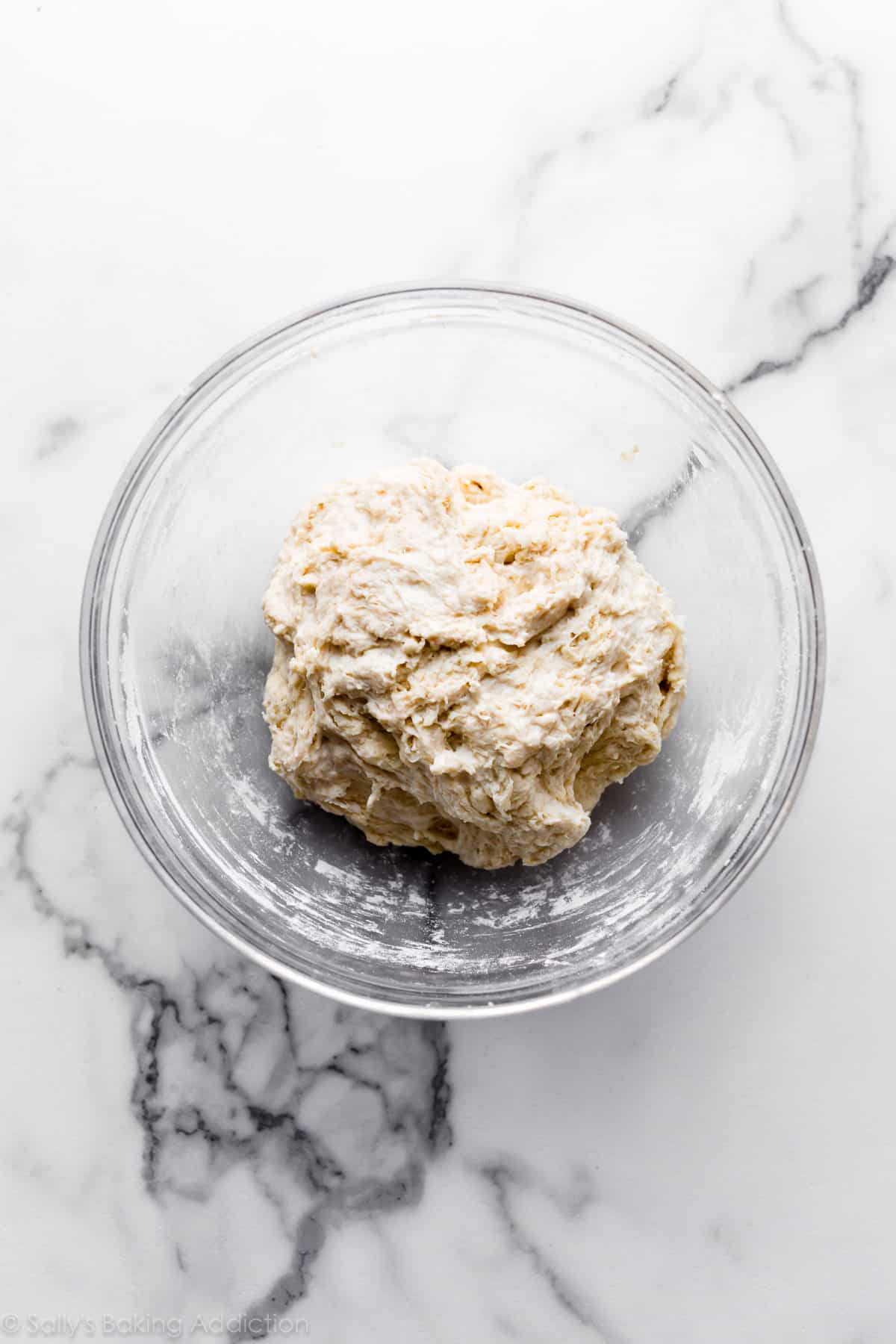
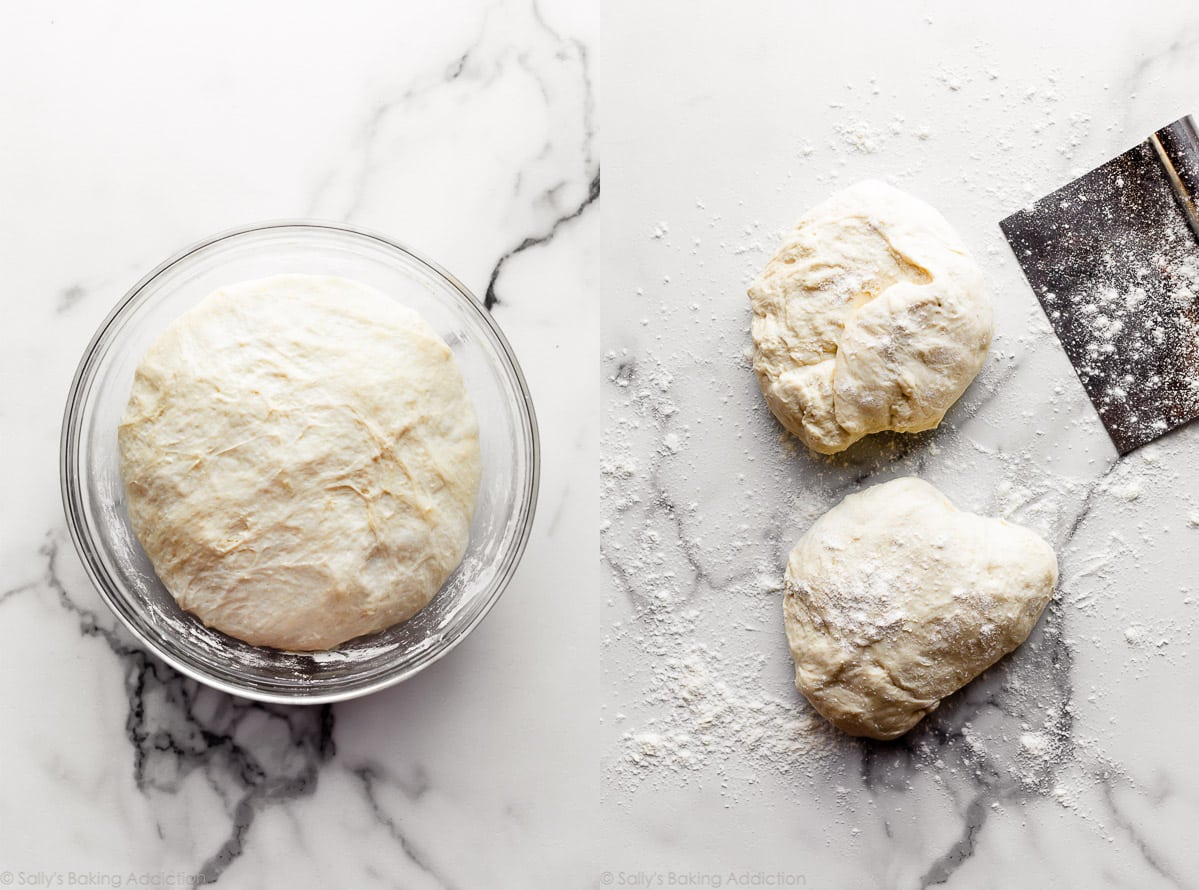
Baker’s Tip: Avoid adding too much flour to the dough as you work with it. The stickier it is—and the longer it sits in the refrigerator—the more likely you’ll have those big airy pockets of air in the crumb.
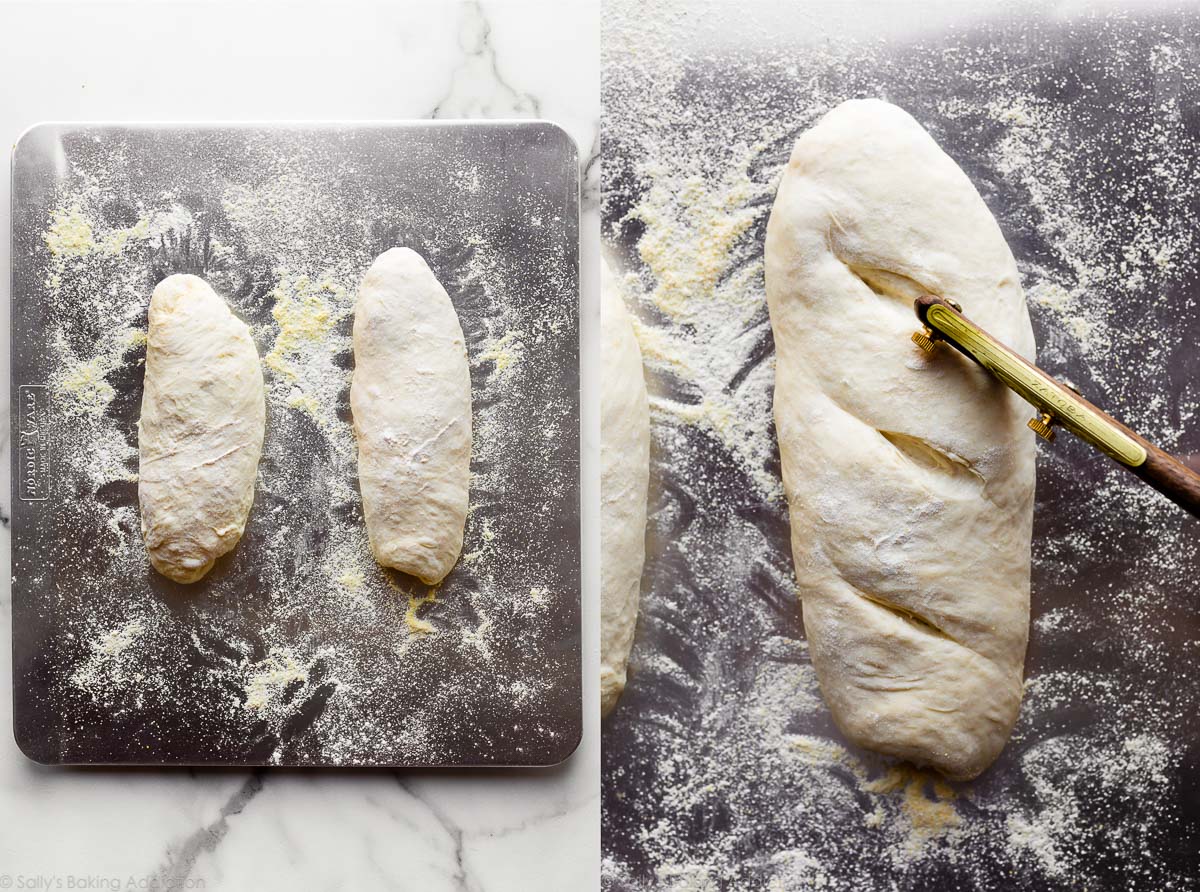
How to Make Homemade Artisan Bread in 5 Steps
- Mix the dough ingredients together. At first the dough will seem very dry and shaggy and you’ll question if it will even come together. But it will. Use a spatula at first, then switch to your hands to ensure all of the flour is moistened. The dough is actually a little sticky after it’s thoroughly mixed.
- Let it rise at room temperature for 2-3 hours. Cover the dough and let it rise at room temperature for about 2-3 hours until doubled in size.
- Use right away or refrigerate. After 2-3 hours, you can immediately continue with the next step. However, for ideal flavor and texture, I strongly recommend letting the dough sit in the refrigerator for at least 12 hours and up to 3 days. Yes, 3 full days! I usually only let it rest for about 18 hours. During this crucial step, the cold air slows the fermentation process and adds so much flavor and texture. So, you can bake bread in 2-3 hours or in 3 days. The longer it sits, the better it tastes. 🙂
- Shape into 2 loaves or 1 boule. Rest as oven preheats. You can shape the bread into a round loaf (boule) or two longer loaves. I usually make 2 longer loaves side-by-side on a flat baking sheet, about 9×3 inches each. Score with a sharp knife or bread lame. Preheat the oven to a very hot 475°F (246°C). The extremely hot air will immediately set the crust so the bread rises up instead of spreading all over. To help ensure a crispier crust, after the oven pre-heats—pour boiling water into a metal or cast iron baking pan/dish on the bottom oven rack. Immediately place the dough inside and shut the oven door to trap the steam. The steam will help create that coveted crisp crust. If you have a dutch oven, shape the dough into 1 round loaf, and bake it inside the dutch oven with the lid on.
- Bake until golden brown, about 20-25 minutes. Gently tap the loaves because if they sound hollow, they’re done.
Look at those deliciously soft holes inside! Reminds me of ciabatta or a French baguette, both of which can be a little more complicated to make.
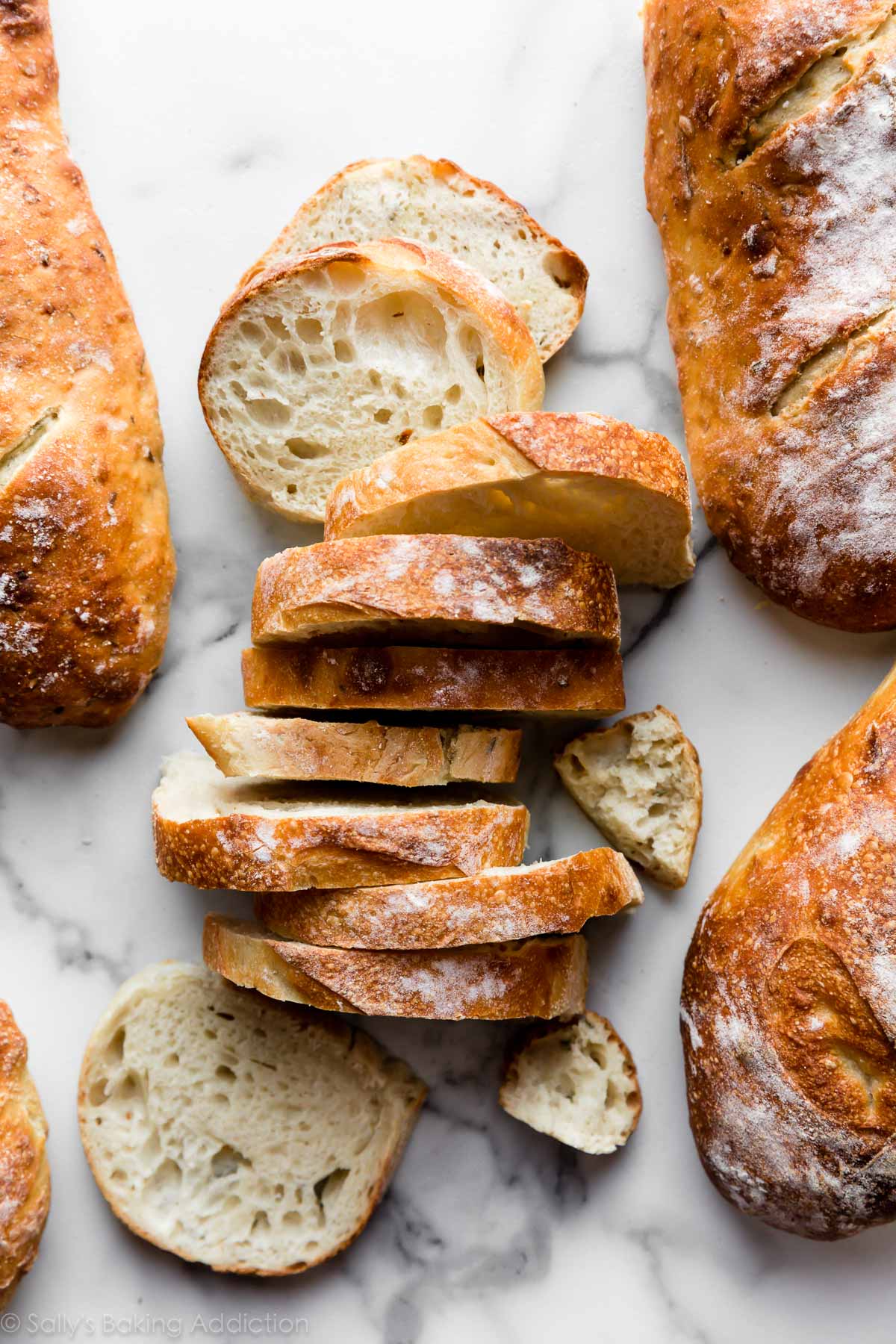
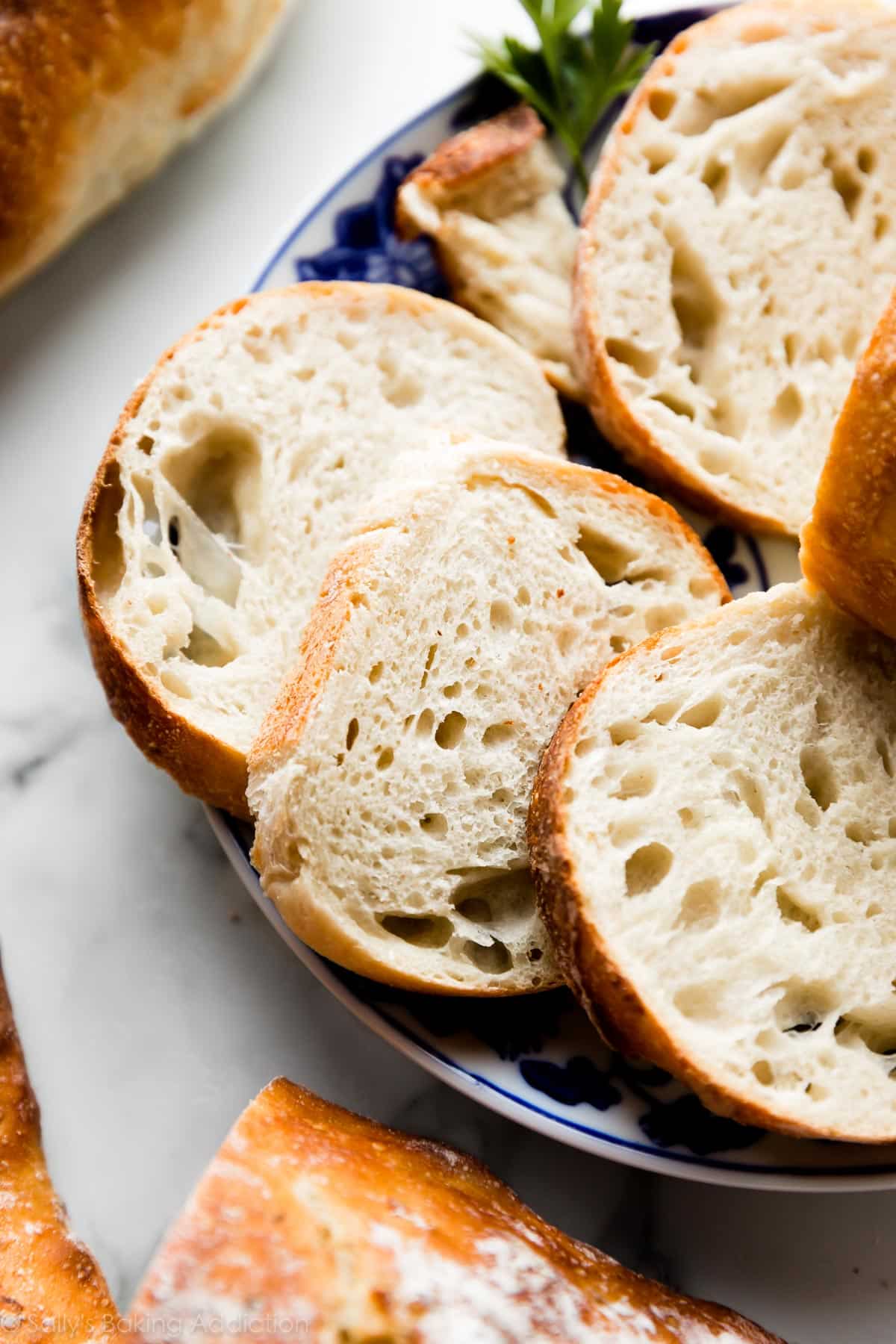
Serve Artisan Bread With
- Slather with homemade honey butter
- Slice and dunk in crab dip, beer cheese dip, or garlic & bacon spinach dip
- Serve alongside slow cooker chicken chili or pumpkin chili
- As a dunker for minestrone soup, creamy chicken noodle soup, or crab soup
- With a big bowl of mac & cheese or spaghetti with slow cooker turkey meatballs
- Use for my goat cheese & honey crostini
- It’s the perfect starch in breakfast casserole or baked apple cider French toast
- With anything because homemade bread is everything’s best friend
See Your Homemade Artisan Bread!
Many readers tried this recipe as part of a baking challenge! Feel free to email or share your recipe photos with us on social media. 🙂
Print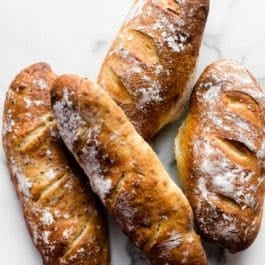
Homemade Artisan Bread Recipe
- Prep Time: 4 hours
- Cook Time: 25 minutes
- Total Time: 4 hours, 25 minutes
- Yield: 2 8-inch loaves
- Category: Bread
- Method: Baking
- Cuisine: American
Description
Even if you’ve never made homemade bread or worked with yeast before, this homemade artisan bread is for you. Watch the video tutorial below and review the recipe instructions and recipe notes prior to beginning. If you’re new to working with yeast, reference my Baking with Yeast Guide for answers to common yeast FAQs.
Ingredients
- 3 and 1/4 cups (about 430g) bread flour (spooned & leveled), plus more for hands and pan
- 2 teaspoons (about 6g) instant yeast
- 2 teaspoons (about 9g) coarse salt (see note)
- 1 and 1/2 cups (360ml) water, close to room temperature at about 70°F (21°C)
- optional: cornmeal for dusting pan
Instructions
- In a large un-greased mixing bowl, whisk the flour, yeast, and salt together. Pour in the water and gently mix together with a silicone spatula or wooden spoon. The dough will seem dry and shaggy, but keep working it until all the flour is moistened. If needed, use your hands (as I do in the video tutorial below) to work the dough ingredients together. The dough will be sticky. Shape into a ball in the bowl as best you can.
- Keeping the dough in the bowl, cover the dough tightly with plastic wrap or aluminum foil and set on the counter at room temperature (honestly any normal room temperature is fine!). Allow to rise for 2-3 hours. The dough will just about double in size, stick to the sides of the bowl, and have a lot of air bubbles.
- You can continue with step 4 immediately, but for absolute best flavor and texture, I strongly recommend letting this risen dough rest in the refrigerator for at least 12 hours and up to 3 days. Place covered dough in the refrigerator for 12 hours – 3 days. I usually let it rest in the refrigerator for about 18 hours. The dough will puff up during this time, but may begin to deflate after 2 days. That’s fine and normal—nothing to worry about.
- Lightly dust a large nonstick baking sheet (with or without rims and make sure it’s nonstick) with flour and/or cornmeal. Turn the cold dough out onto a floured work surface. Using a sharp knife or bench scraper, cut dough in half. Some air bubbles will deflate as you work with it. Place dough halves on prepared baking sheet. Using floured hands, shape into 2 long loaves about 9×3 inches each (doesn’t have to be exact) about 3 inches apart. Loosely cover and allow to rest for 45 minutes. You will bake the dough on this prepared baking sheet.
- During this 45 minutes, preheat the oven to 475°F (246°C).
- When ready to bake, using a very sharp knife or bread lame (some even use kitchen shears), score the bread loaves with 3 slashes, about 1/2 inch deep. (“Score” = shallow cut.) If the shaped loaves flattened out during the 45 minutes, use floured hands to narrow them out along the sides again.
- Optional for a slightly crispier crust: After the oven is preheated and bread is scored, place a shallow metal or cast iron baking pan or skillet (I usually use a metal 9×13-inch baking pan) on the bottom oven rack. Carefully and quickly pour 3-4 cups of boiling water into it. Place the scored dough/baking pan on a higher rack and quickly shut the oven, trapping the steam inside. The steam helps create a crispier crust.
- Place the shaped and scored dough (on the flour/cornmeal dusted pan) in the preheated oven on the center rack. Bake for 20-25 minutes or until the crust is golden brown. Gently tap the loaves—if they sound hollow, the bread is done. For a more accurate test of doneness, the bread is done when an instant read thermometer inserted in the center reads 195°F (90°C).
- Remove the bread from the oven and allow to cool for at least 5 minutes before slicing and serving. Store leftovers loosely covered at room temperature for up to 5 days or in the refrigerator for up to 10 days.
Notes
- Make Ahead & Freezing Instructions: The dough can sit in the refrigerator for up to 3 days, so this is a wonderful recipe to begin ahead of time. You can also bake the bread, allow it to cool, and freeze for up to 3 months. Thaw in the refrigerator and allow to come to room temperature before serving. You can also freeze the dough. Complete the recipe through step 3. Wrap in plastic wrap and place in a freezer-friendly container. To bake, allow dough to thaw overnight in the refrigerator, or for 2-3 hours at room temperature. Continue with step 4 and the rest of the recipe instructions.
- Special Tools (affiliate links): Glass Mixing Bowls | Silicone Spatula or Wooden Spoon | Baking Sheets | 2-cup Measuring Cup | Bread Lame | Instant Read Thermometer
- Flour: For absolute best flavor and chewy texture, I strongly recommend using bread flour. You can use a 1:1 substitution of all-purpose flour in a pinch with no other changes to the recipe. I recommend avoiding whole wheat flour in this dough. If necessary, use half bread flour and half whole wheat flour. The bread will taste a bit dense.
- Yeast: You can use instant or active dry yeast, but I highly recommend an instant (aka “rapid rise” or “quick rise” yeast). The bread will rise faster. I usually use Platinum yeast by Red Star, which is an instant yeast. 2 teaspoons is a little less than 1 standard packet. If using active dry yeast, there are no changes needed to the recipe. The rise time in step 2 may take longer.
- Salt: Use a coarse salt, such as coarse sea salt, in this bread. I find the flavor slightly lacking when using regular table fine salt. If you only have fine salt, reduce to 1 and 1/2 teaspoons.
- Water: Use cool water. 70°F (21°C) is great, but the exact temperature doesn’t matter as long as it’s not hot or warm.
- Round Loaf: If you want to shape the dough into a boule (round loaf) simply shape into a round ball instead of 2 loaves in step 4. Baking instructions are the same, but the loaf will take a few extra minutes in the oven. If you want to bake the boule in a dutch oven, see next note.
- Using a Dutch Oven: Follow this dough recipe through step 3, then follow the simple shaping/baking instructions (steps 2-5) in my Cranberry Nut No Knead Bread recipe including using the parchment paper. If your parchment paper can’t withstand heat this high, you can either lower the oven temperature and bake the bread for longer or grease the Dutch oven instead.
- Using a pizza stone: If you want to bake your bread loaves on a pizza stone, place pizza stone in the preheating oven. In step 8, place the shaped and scored dough on your preheated pizza stone. If the bottom of the shaped dough is pretty sticky, dust the hot pizza stone with some extra cornmeal. Bake as directed.
- No Nonstick Pan: If you don’t have a nonstick baking sheet, line it with parchment paper instead. Coat with a dusting of flour and/or cornmeal before placing the dough on top. Parchment paper can burn, so it’s best to check the box to see how much heat yours can tolerate. Lower your oven heat if necessary and bake the bread for longer until golden brown and when gently tapped, sound hollow.
- Flavor ideas: Before pouring in the water in step 1, add any of the following ingredients/combination of ingredients to the dry ingredients in the bowl: 4 cloves minced garlic + 3 Tablespoons chopped rosemary, 3 Tablespoons your favorite fresh herb (chopped), 1 cup your favorite shredded cheese, a diced jalapeño, 3/4 – 1 cup dried cranberries and/or chopped nuts, 2 teaspoons garlic powder, etc.
- Reference my Baking with Yeast Guide for answers to common yeast FAQs.
- Recipe adapted from King Arthur Flour & Red Star Yeast, similar method originally from Jim Lahey.
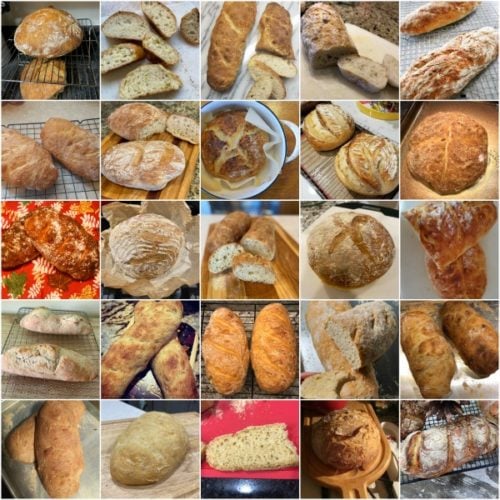
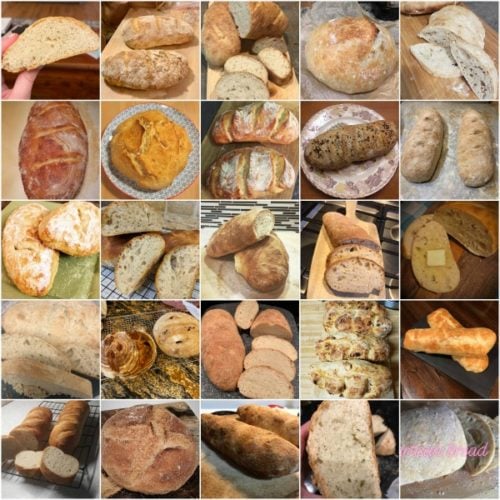
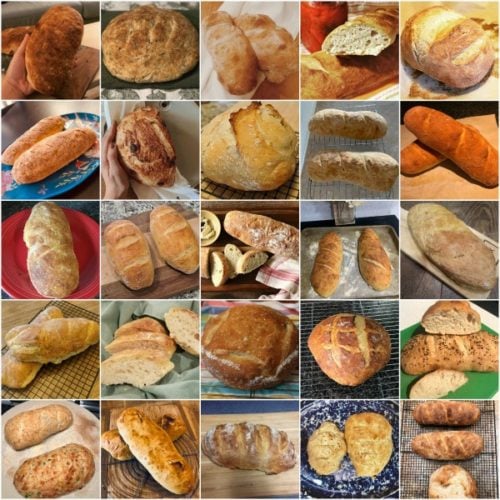
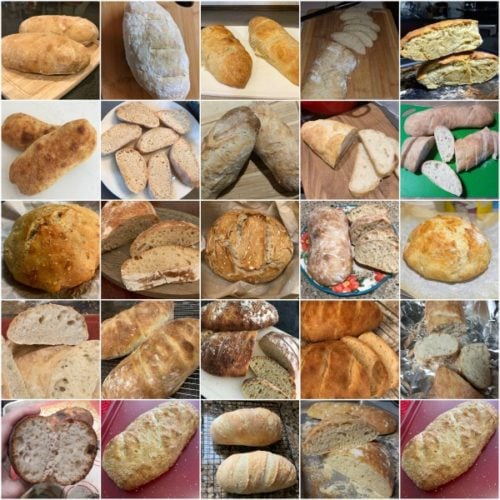
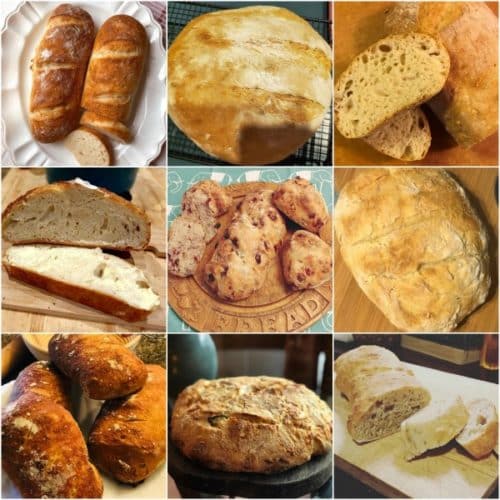
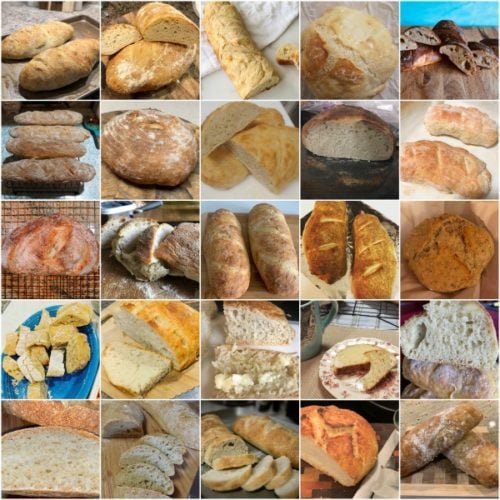
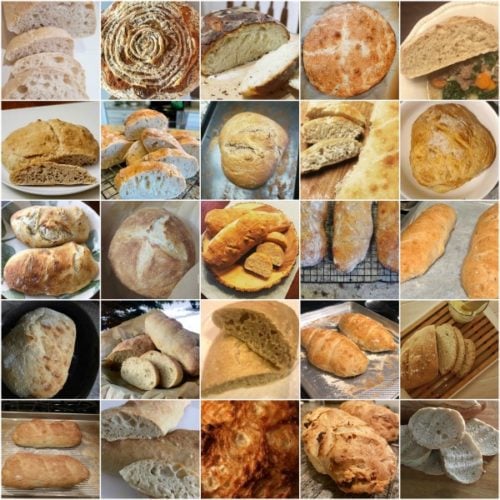
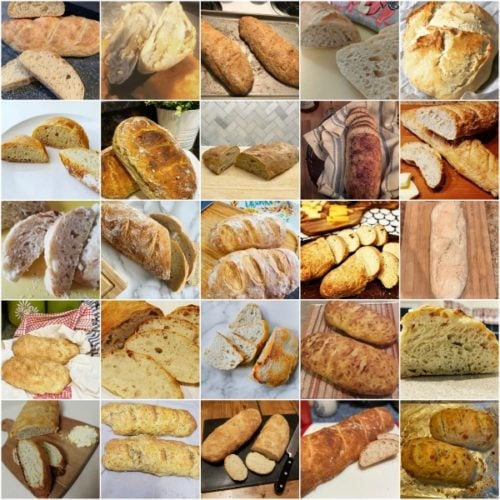
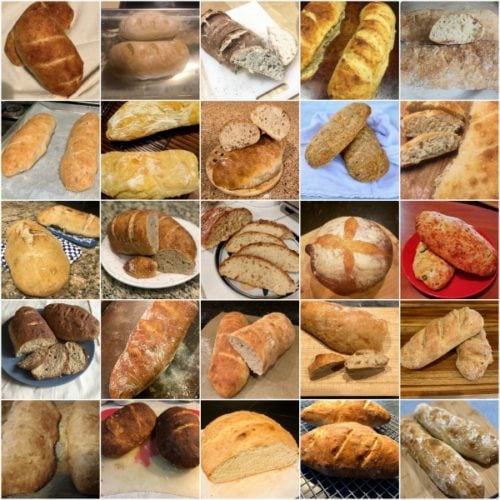
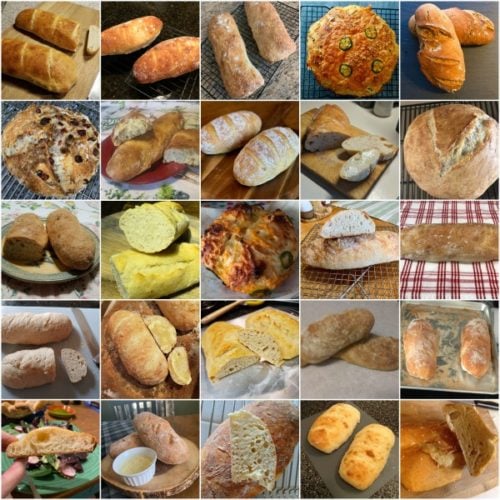
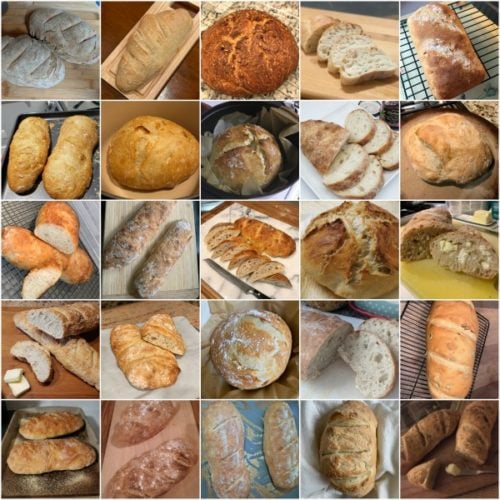
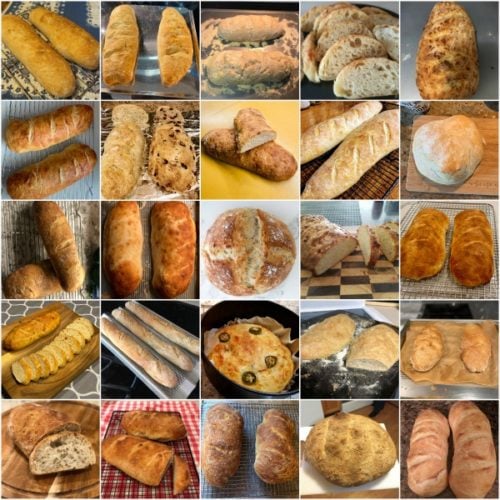
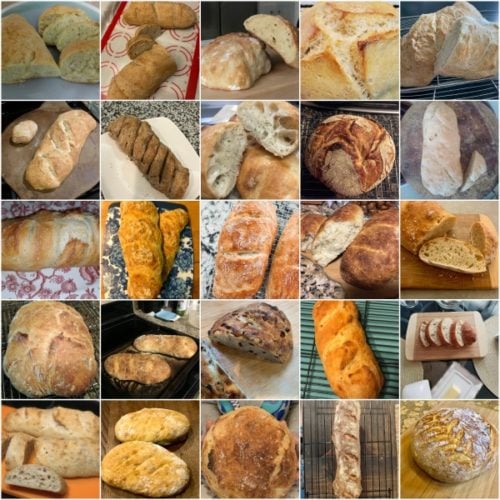
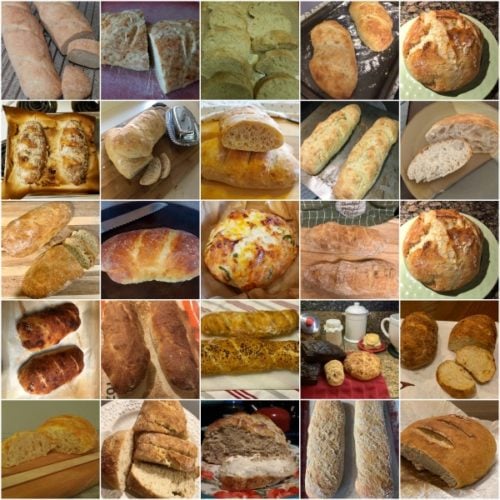
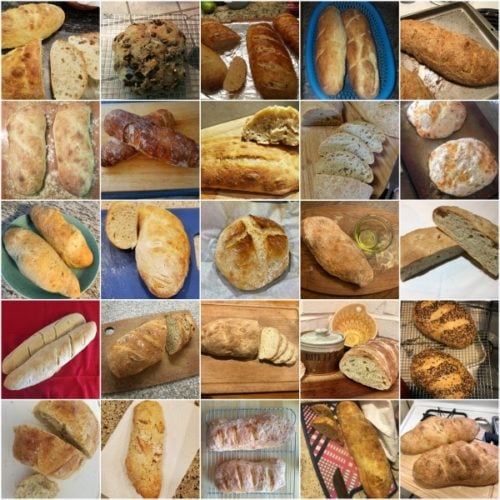
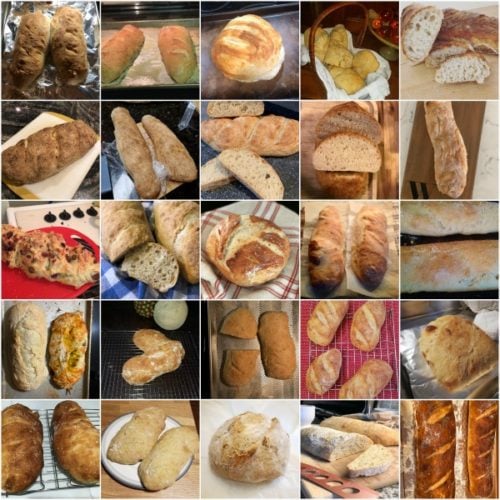

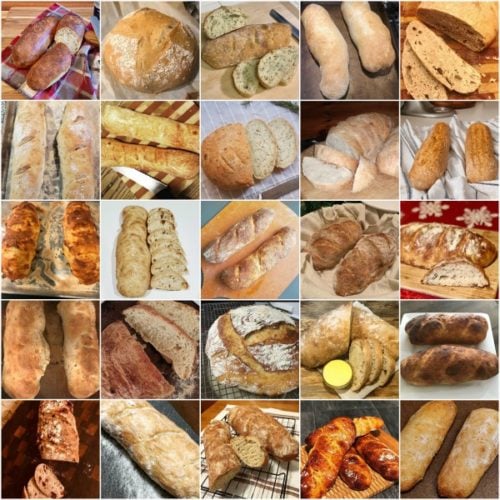
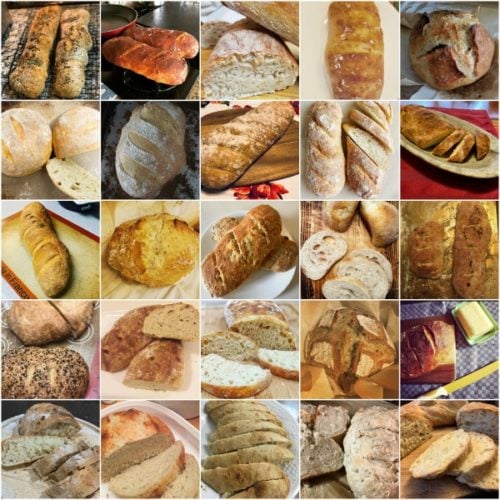
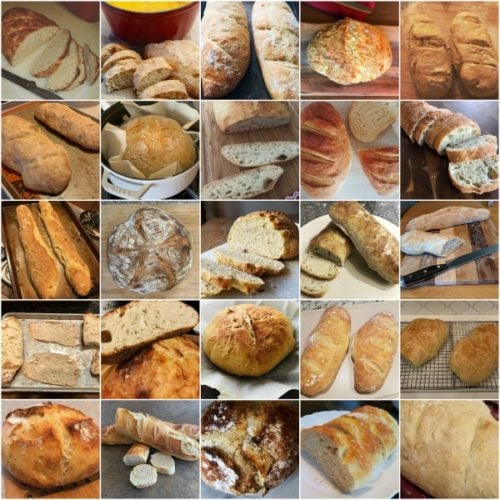
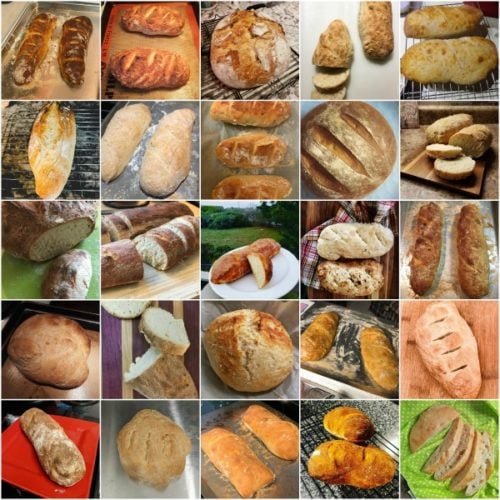
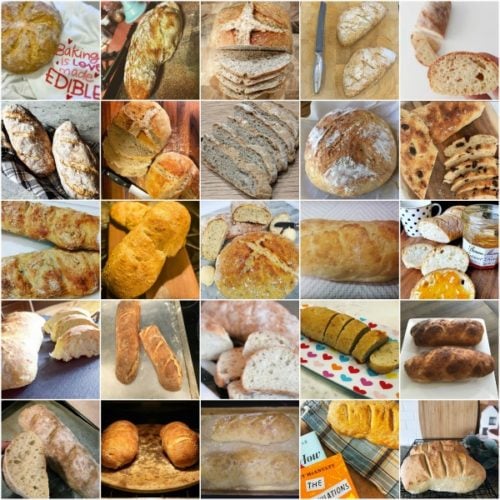
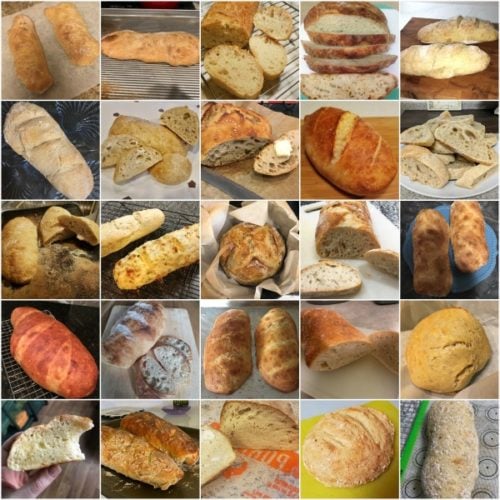
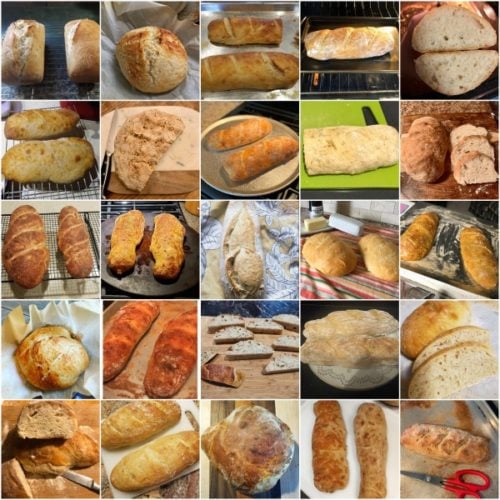
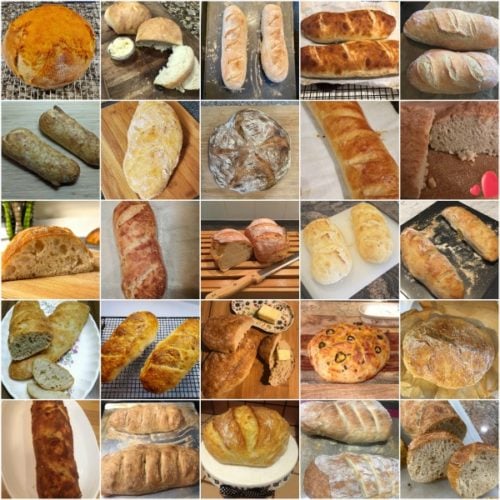
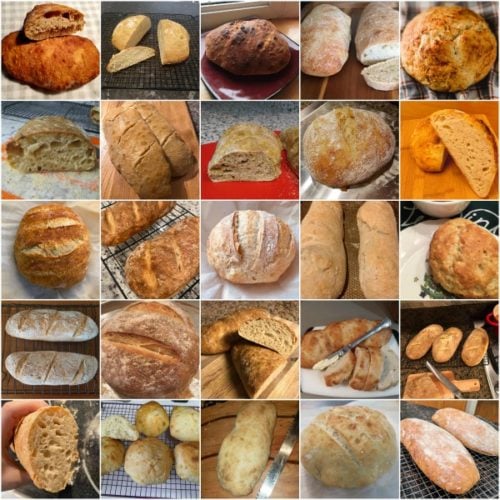
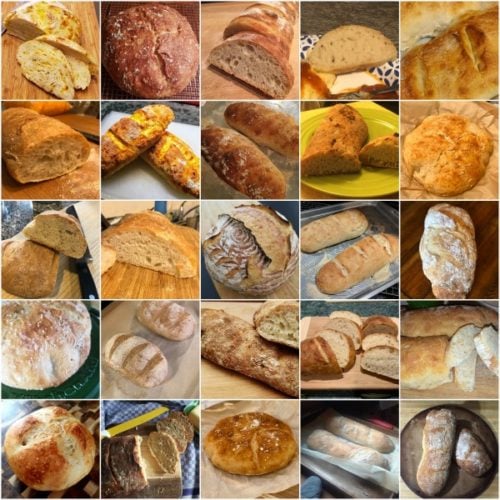
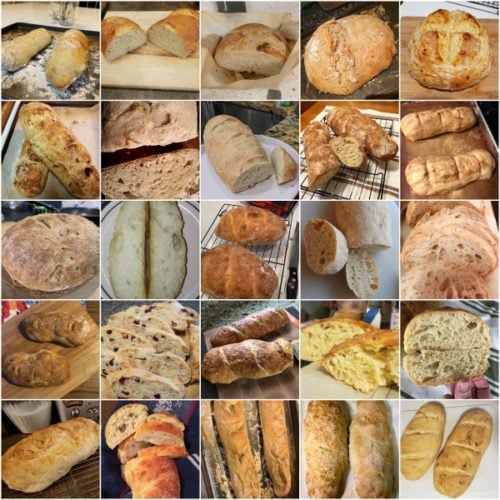
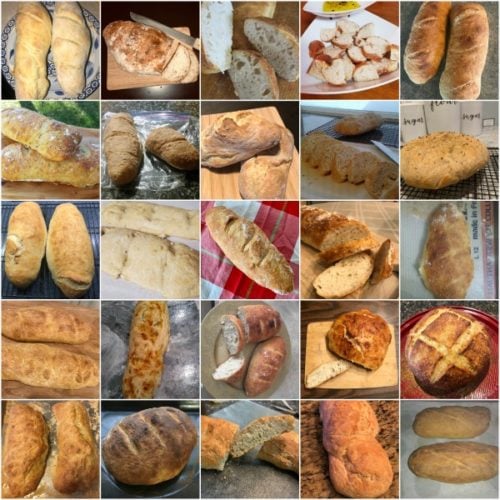

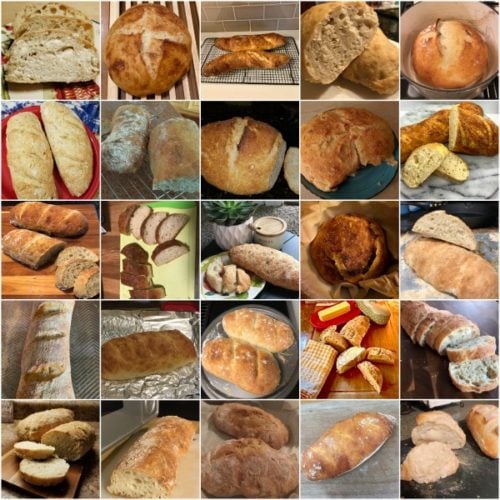
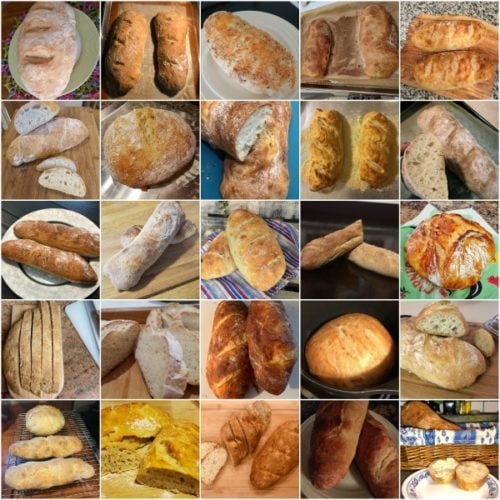
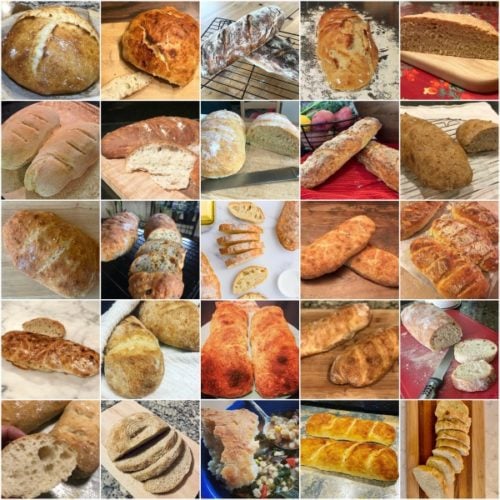
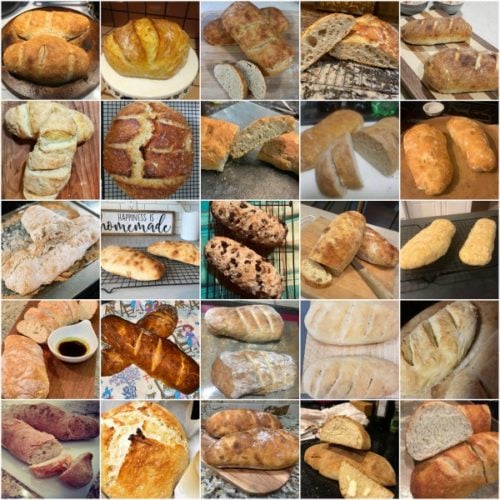
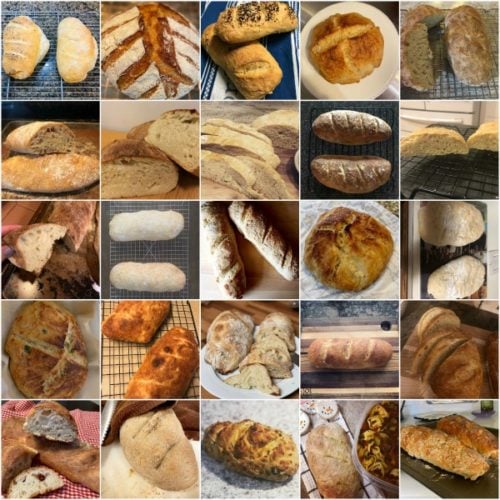
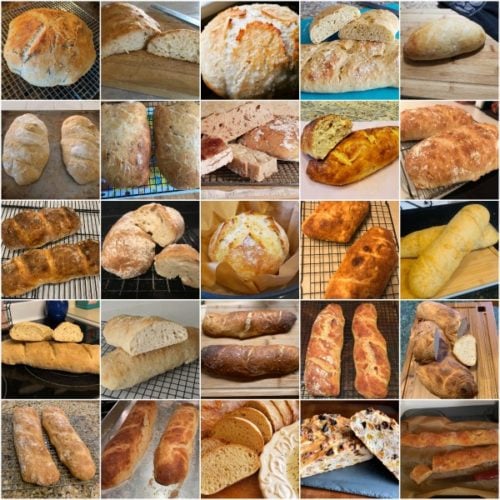
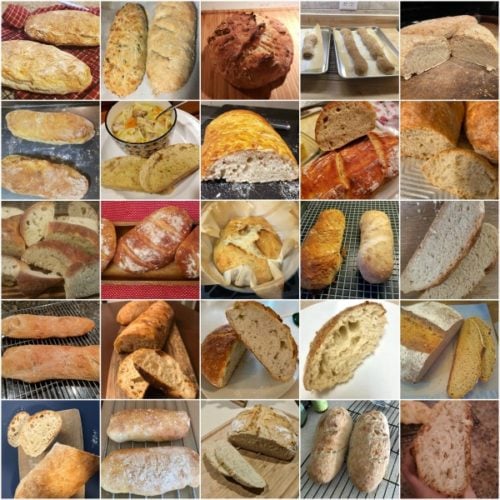
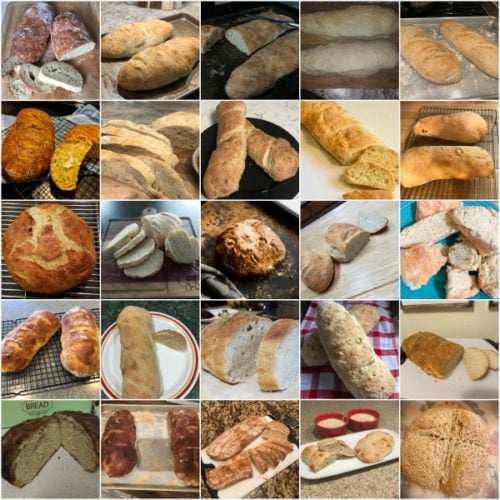
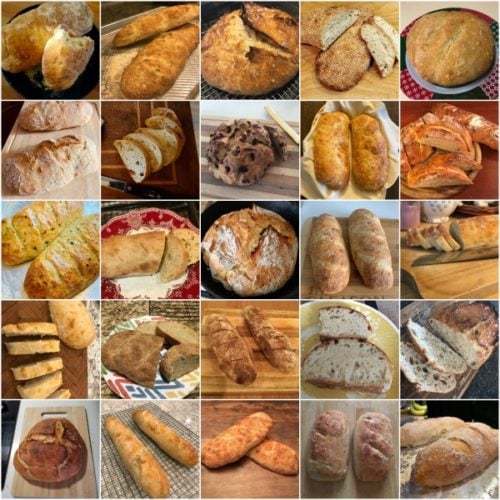

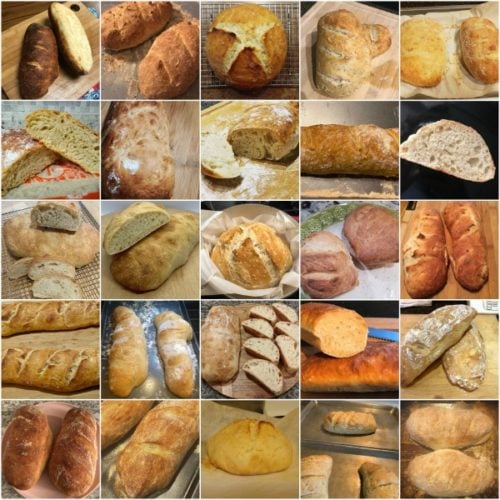
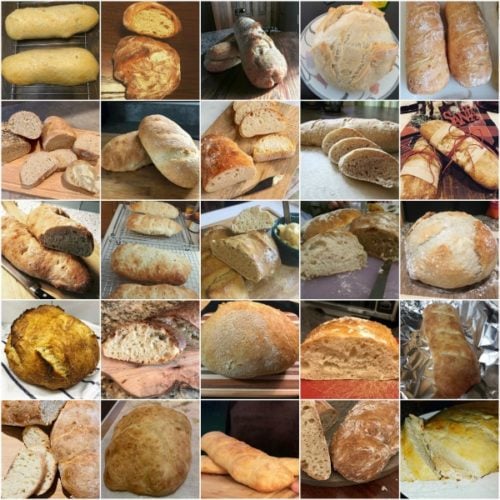
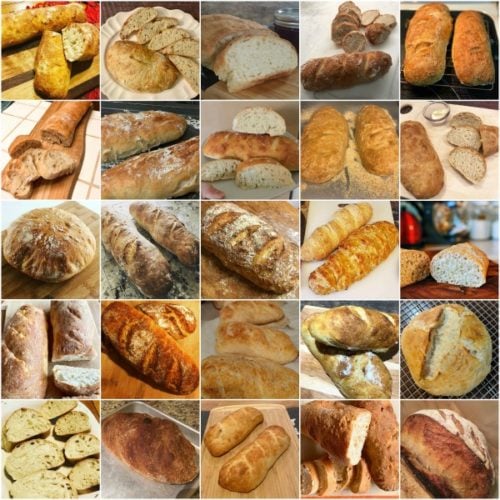
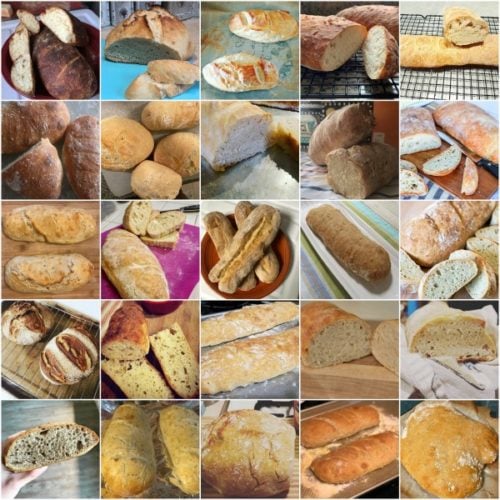
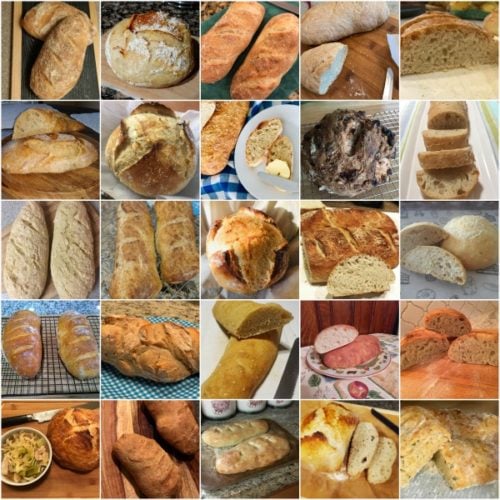
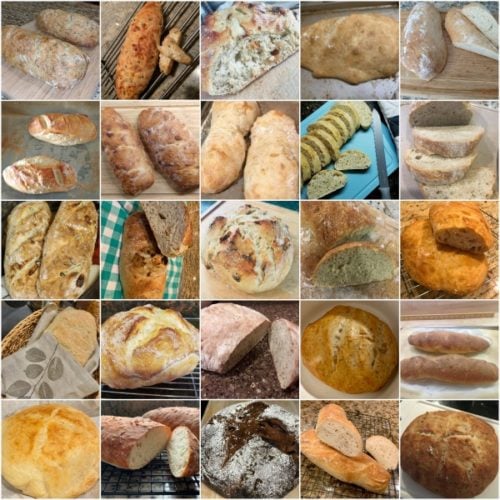
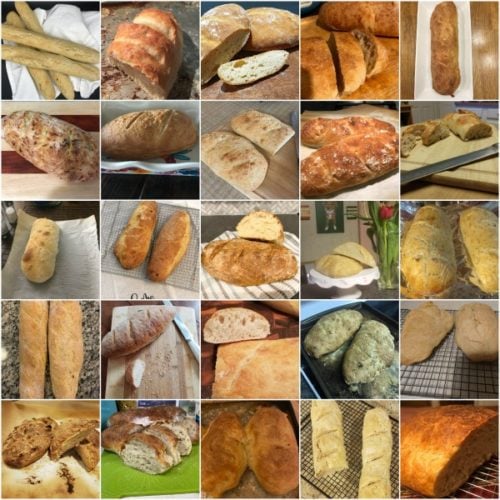
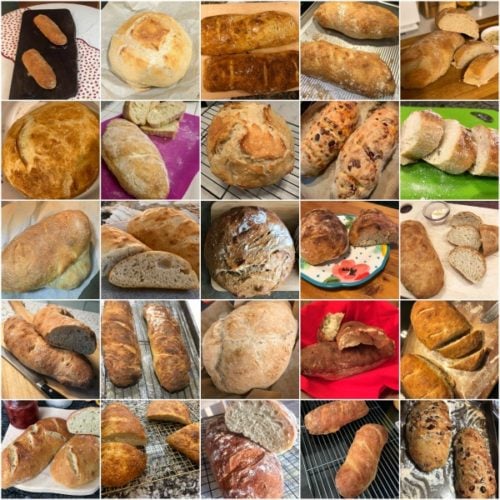
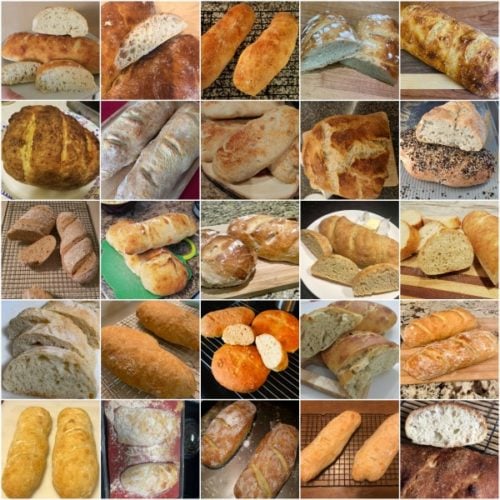
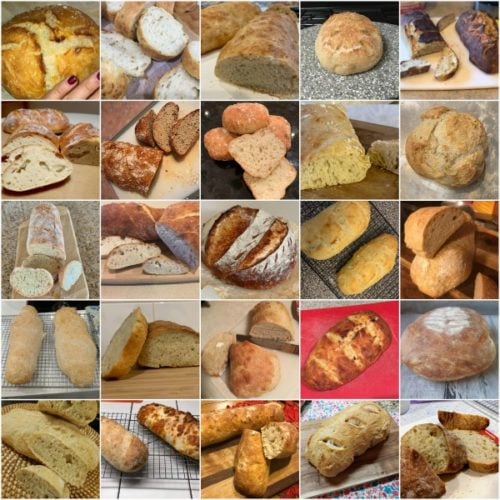
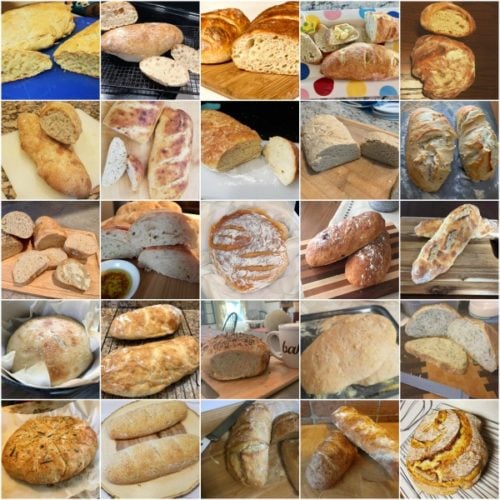
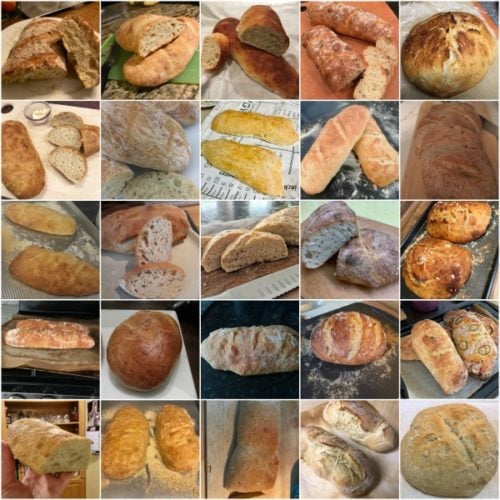
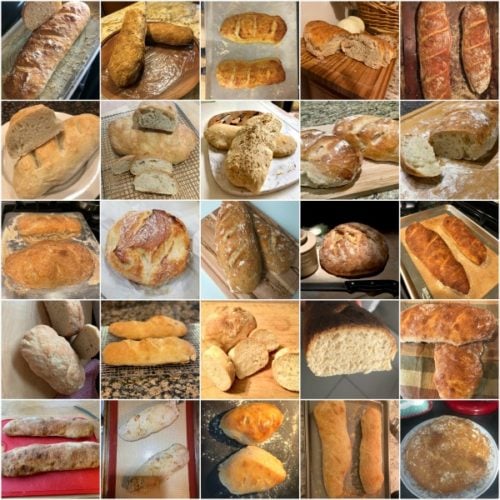
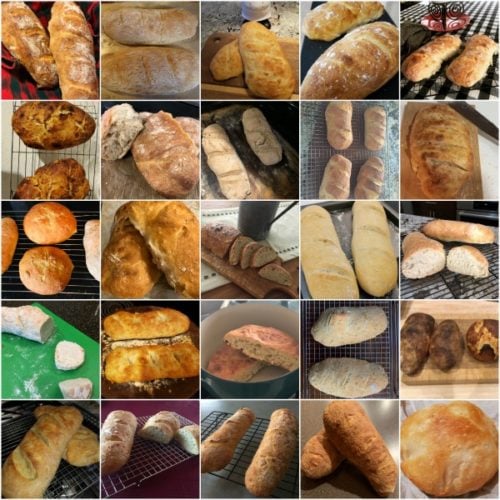
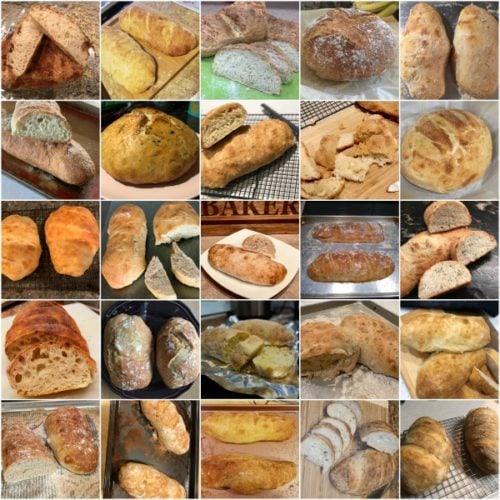
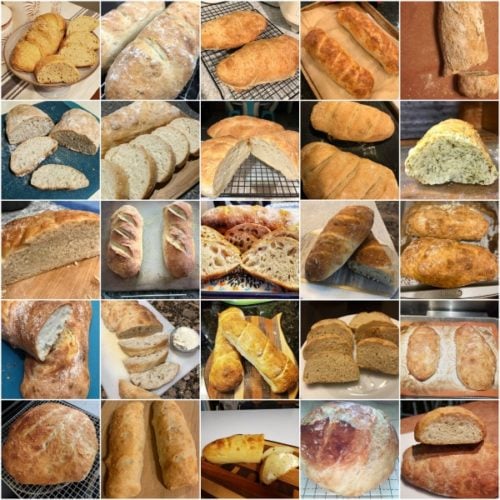
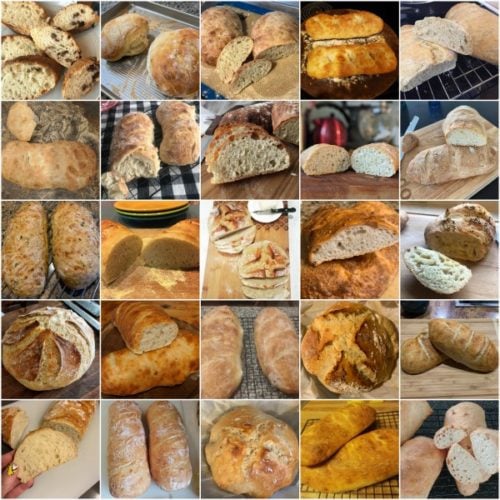





















ive made this bread many times and I’m always amazed how it’s always so nice and the same! but today it was mysteriously still a bit uncooked in the center. i felt it was a bit dryer than normal as i was mixing it (i’m sure i got the right measurements). what did i do wrong or differently i wonder? thank you!
Hi Nick, was the weather a bit different than normal? The level of humidity in the air can greatly impact yeasted doughs/breads. It sounds like the bread could have benefitted from a few additional minutes in the oven—do you have an instant-read thermometer? That’s especially helpful for making sure the bread is fully baked through. We hope this helps and are glad to hear it’s a favorite for you!
Wow!! I am shocked as to how good this was!! I got up wanting to make something new and found we were out of bread so I came to your website and found this recipe. My family has a bread recipe that is our standby so everyone was a little sceptical of this one, especially when they heard there was no oil on it, but we are all loved it!! Thank you! I’ll be making this again!!!
After the first rise (2-3 hrs) can I cut it in half? Make one loaf for today and put the other half in the fridge for tomorrow?
Hi Leslie, that should work just fine. Enjoy!
Can I use loaf pans instead of a baking sheet? I want my bread to look/take the shape of a loaf pan. Thanks!
Hi Joan, There is a little too much dough for a standard size (9×5-inch) loaf pan, so you could try dividing the dough in half and using 2 loaf pans. The edges should still crisp up and the bake time may vary.
I’ve made this bread at least 10 times, varying the herbs and spices I add to it! Do you have any tips if I would like it to rise a bit more when baking? It tastes perfect but sometimes I’d like it if it was a bit more “airy”?
Hi Charles, Every loaf will turn out differently. Make sure to handle the dough very carefully to prevent compressing the air bubbles.
I made this and the flavor is so good! The inside is more spongy than airy. Is this what I should expect?
Hi Raychel, Every loaf will turn out differently. Make sure to handle the dough very carefully to prevent compressing the air bubbles for a more airy loaf.
So so so easy and came out delicious first time!
I am just trying this recipe and I’m confused. After it has risen for 2-3 hours, do I punch it down and shape it before putting in the refrigerator? Or maybe just punch it down and shape it after it comes out and then let it rise again?
I have looked at this recipe before, and finally am doing it when I have enough time because it’s for dinner tomorrow night.
Hi Cynthia! You don’t punch this dough down. After 2-3 hours, you can bake it or let the dough rest in the fridge before shaping and baking. The video tutorial should be helpful above!
After the initial 2-3 hour rise, do I punch the dough down before putting it in the fridge for a couple days?
Hi Josh, you don’t punch this dough down. After 2-3 hours, you can bake it or let the dough rest in the fridge before shaping and baking. The video tutorial should be helpful above!
I forgot to rate it 🙂
I made this yesterday and is was so simple to put together. I let it sit in the fridge about 24 hours. And I baked it with a pan of water as suggested. It came out perfect! The crust had the perfect chew to it. I love this recipe and will make it again.
This is hands down my favorite bread recipe. I literally make it every week and it’s so good. I also love adding the rosemary and garlic too and have had people rave about it. It’s so foolproof that I tell everyone about it! Thank you so much for this recipe! I’m definitely going to try someone else’s suggestion to add cinnamon and raisins next.
I made the dough last night and baked this today. Total hit. Everyone loves it! And for a family of 7 that’s a feat 🙂 It’s our new favorite for bread with dinner. Thanks so much!
Hello! I am wanting to use this for sandwiches. What would be the best sizes to cut the dough into to make like individual sandwich loaves?
Hi Macie, There is a little too much dough for a standard size (9×5-inch) loaf pan, so you could try dividing the dough in half and using 2 loaf pans. The edges should still crisp up and the bake time may vary. Or, here is our sandwich bread recipe if you’re interested.
Hi. Can I cook this bread in a loaf pan?
Hi Kathy, There is a little too much dough for a standard size (9×5-inch) loaf pan, so you could try dividing the dough in half and using 2 loaf pans. The edges should still crisp up and the bake time may vary.
hi sally im currently working on this recipe but im wondering if I can add butter garlic spring onion mix into the dough?
Hi AK, is it a dry mix? If so, that should work just fine!
First time ever baking bread and it turned out really good! Only problem is it stuck to the pan after baking and tore. Should I have put flour on the bottom to prevent this since the dough is so sticky? Thanks!
Hi Kelly, yes, we recommend dusting the pan to prevent just that! See step 4: “Lightly dust a large nonstick baking sheet (with or without rims and make sure it’s nonstick) with flour and/or cornmeal.” We’re glad you still enjoyed the bread!
Love the recipe
What’s the calorie etc?
Hi Jean, We don’t usually include nutrition information as it can vary between different brands of the same ingredients. Plus, many recipes have ingredient substitutions or optional ingredients listed. However, there are many handy online calculators where you can plug in and customize your exact ingredients/brands. Readers have found this one especially helpful: https://www.verywellfit.com/recipe-nutrition-analyzer-4157076
This is the best way to make bread. Tastes great. Super easy. Key ingredients are patience and a scale.
Such an amazing recipe but I keep doing something wrong. I let it rise for 3 hours but my dough didn’t double in size. So when I baked it, it was super dense with no air bubbles. Any ideas on what I did wrong and how I can correct it?
Hi Skye, happy to help troubleshoot. Make sure to handle the dough very carefully to prevent compressing the air bubbles. Be sure to also spoon and level your flour (or use a kitchen scale) to ensure it’s not over-measured, which can make the bread dry and dense. Are you using instant yeast or active dry? Active dry can take a little longer to rise. Be sure your yeast is not expired, and a digital thermometer is helpful for ensuring the water temperature isn’t too hot, which can kill the yeast. Hope this helps for next time!
the inside of the bread was delicious the crust though was too crunchy
Hey Louise, I have found that covering the loaf with a cotton tea-towel as soon as its out of the oven, for 10-15mins then remove, softens the crunch a little.
Can whole wheat flour be substituted for bread flour?
Hi Stephanie, we recommend avoiding whole wheat flour in this dough. If necessary, use half bread flour and half whole wheat flour. The bread will taste a bit dense.
This is the best bread recipe ever. My son told me to throw out the bread machine. Make this only. Perfect bread alongside dinner. And so easy. Just plan ahead. Who knew you could store the dough in the fridge for a few days, waiting for the right meal? If you have the self control to wait. Love it. Thanks, Sally!
How would one go about adding sliced onion to this recipe?
Hi LR, we haven’t tested it, but a few readers have reported success adding sauteed onions to the bread. Be sure to blot dry, too. You could also add some onion powder for more flavor.
I have a small oven with only one rack and an exposed element on the oven floor. I’ve seen recipes that recommend a water spray bottle to spritz the loaves before baking for the crispy crust – have you tried this? Is it a bad idea? Thanks.
Hi Ruth, we haven’t tested that method, but it doesn’t sound like it would harm anything to try it, so I’d say go for it and see how it turns out!
I followed the steps exactly, after the first rise at room temp I put the dough in the fridge for 24h to let the taste develop, but when it came to baking it the dough was too liquid to shape. I put it in a cast-iron casserole to bake it, and had to bake it for twice as long as indicated. The crust was nice and firm to the touch, but it’s completely flat and very hard to cut. It tastes good, but I won’t be making it again. I’m not a novice baker either, so I don’t know how everybody else seems to have got such amazing results.
Sally, I’ve made this recipe numerous times, and I love it! Would this recipe be doubled easily!
Hi Brenda, we’re so glad you love it! For best results, we recommend making two separate batches rather than doubling.
Yes i had the same issue with it being too wet!! I Baked in two “loaves” and the crust was fine but inside was very gummy and wet even with 196f thermometer reading! I don’t know where i went wrong
I had the same problem. Refrigerating it completely deflated the dough. I’m not a novice either, so I get your frustration. I figure I’ll freeze it and either make a bread pudding or use it for breadcrumbs at some point. I might try the recipe again and skip using the fridge.
I love this recipe I’ve made it twice rightness the house smells like homemade bread and I added rosemary and roasted garlic this time. You are brilliant with your recipes. Thank you
In your instructions you mention the pan of water when baking but this is not part of the video. Is the water necessary?
Hi Celesta, that is an optional step to help create an even crispier crust. Feel free to skip it if you wish.
Sally, I’ve been making this since I found your recipe. t’s so delicious I could eat an entire loaf. Recently I have been experimenting by adding dry herbs. I would like to make this for a friend who loves cinnamon raison bread. Could you please tell me the amount of cinnamon and raisins to use. Thanks for your wonderful recipes!
Hi Diane, we’re glad this is a favorite for you! About a cup of raisins can be added as well as cinnamon to your taste. Add in step 1 when you mix the flour, yeast, and salt.
Sorry to bother you again, but how much cinnamon would I add to the bread.
Thanks you
Hey! I made this in a dutch oven and loved it! How would you suggest reheating it?
Hi Hillary, we’re so glad you loved it! Timing will really depend—reheat in the toaster or microwave until warmed to your liking.